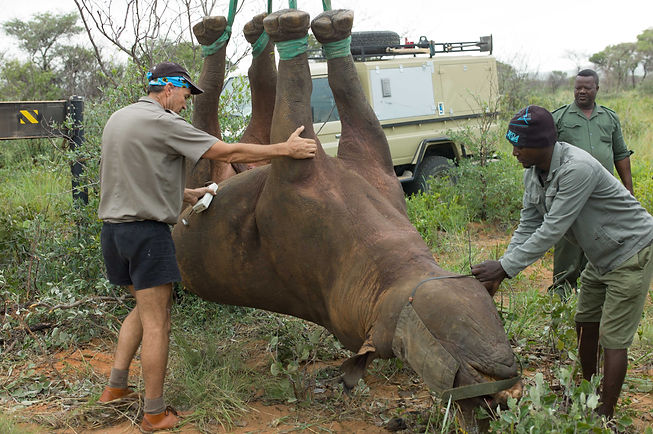
NAMIBIA
Hanging Rhinos in Namibia
In order to protect rhinos living in remote areas from the increasing threat of poaching, conservation scientists have taken new risks that are deemed essential to save the species.
One such risk is that has yet to be characterized is the effects of hanging anesthetized rhinos upside down during helicopter transport. This new method of moving rhinos has gained wide popularity across Africa despite the lack of understanding about the physiologic effect of this process on rhinoceros breathing and health. With the generous support of the Namibian Ministry of Environment and Tourism (MET) and its partners, including SRI and the Jiji Foundation, our group has begun exploring the physiologic effects of suspending rhinos in dorsal recumbency (positioning a rhino on its back).

There is no physiologic data assessing the effects of suspension in dorsal recumbency on which to base an estimate of risk to the suspended rhinoceros. But observations in horses in similar positions suggest that this posture is likely to impair heart and lung function even more than transportation in lateral recumbency (positioning a rhino on its side) on an airborne platform.
From 7-24 April 2015, our team capture a number of black and white rhinos in Waterberg National Park for management procedures. We took advantage of the unusually good vehicular access on the Waterberg plateau, which allowed us to bring a crane to many capture sites. Using the crane, we could make measurements on rhinos safely suspended just above the ground, but in a posture that was the same as if they were being hoisted under a helicopter. Twelve black rhinos randomly selected to evaluate the effects of “hanging” on the cardiovascular and respiratory systems.


Each rhino was carefully weighed and measured so that the physiologic and biologic variables of breathing could be compared in rhinos of varying body size. Weight measurements will also be correlated to spine length and girth length to enable the development of a weight-estimation formula that can be used to judge body mass using body measurements when a scale is no available.
The subject rhinos were assigned to one of two treatments groups: 1) lateral posture and 2) hanging posture (suspended by their feet from a crane). Each rhino received both treatments (lateral and hanging) and the sequence of the treatments was randomized to prevent error from time in each position.


While the data is currently being analyzed, we were delighted to learn that the physiological effects of hanging rhinos in dorsal recumbency (suspended under a crane) appear to be no worse than positioning them on their side in lateral recumbency. Overall, the results of this work will inform veterinarians working with rhinos in the field and help minimize capture-related morbidity and mortality in these large endangered ungulates.
The MET group is a professional and skilled team that takes seriously their mission to protect and conserve the rhinoceroses and other wildlife of Namibia. This work represents a unique partnership between government, non-profit organisations and Cornell University.







